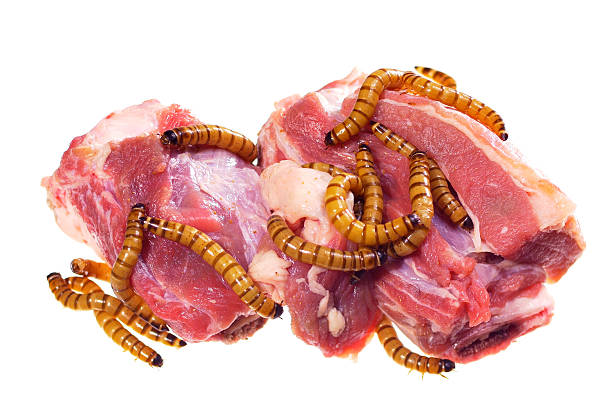Superworm Beetle – Zophobas Morio
The superworm beetle (Zophobas morio) is a species of beetle belonging to the family Tenebrionidae. It is native to Central and South America, but has been introduced to many other parts of the world.
The adult beetle is quite large, measuring around 25 mm in length, and is black in color with yellowish-brown markings. The larvae of this beetle are also known as ‘superworms’ and are often used as a live food source for reptiles, amphibians, birds, and fish.
Superworm Beetle – Zophobas Morio
Superworms are also popular as bait for fishing. Superworms are easy to care for and can be kept in a container with some bedding material such as oatmeal, cornmeal, or bran.
They should also be provided with some fresh vegetables such as carrots, potatoes, or apples. Superworms are known for their hardiness and long life span, and can live up to five years in captivity when properly cared for.
They are also a very nutritious food source for animals and humans alike, as they are an excellent source of protein. Superworms are a great addition to any pet owner’s collection, and can provide hours of entertainment and nutrition for their beloved pet.
Superworm Beetle: The Mighty Insect That Conquers All
What are superworms? Ever heard of a beetle that can survive being frozen, boiled, crushed, and even radiated? Meet the superworm beetle, also known as Zophobas morio, a powerful insect species that never fails to amaze.
With its robust physique and sturdy exoskeleton, the superworm beetle can withstand extreme temperatures and pressures that would kill most other insects. This incredible resilience has made it a popular choice for scientific research, as well as a fascinating subject for entomologists and nature enthusiasts around the world.
Superworm Beetle: found any where of the world
The superworm beetle is found in many parts of the world, including the Americas and Africa. It is a member of the darkling beetle family, which includes more than 20,000 species of insects.
One of the most striking features of the superworm beetle is its impressive size. Measuring up to 3 centimetres in length, it is one of the largest beetles in its family. It has an elongated, cylindrical body, with a hard, smooth exoskeleton that protects it from external threats.
Zophobas Morio: harmless to humans and animals
Despite its intimidating appearance, the superworm beetle is actually harmless to humans and animals. It feeds mostly on decaying organic matter and plants, and has even been known to clean up crop residue and waste materials.
But what makes the superworm beetle truly special is its ability to survive in some of the most extreme environments on earth. It can withstand temperatures as low as -50 degrees Celsius and as high as 50 degrees Celsius, making it highly adaptable to a range of climates.
Superworm Beetle – Zophobas Morio: resilient to radiation exposure
In addition, the superworm beetle has been found to be resilient to radiation exposure. In laboratory experiments, scientists have discovered that the beetle can survive doses of radiation that would kill other insects outright.
This incredible resilience has made the superworm beetle a valuable research subject for scientists studying the effects of radiation and the potential applications of this insect in future space missions.
In conclusion for what is a superworm, the superworm beetle is not just a fascinating insect; it is a true survivor. Its resilience and adaptability to extreme environments make it a unique and valuable species, and a testament to the amazing power of nature. So, next time you come across a superworm beetle, take a moment to appreciate its tenacity and strength.
How To Identify the Superworm
The Superworm Beetle (Zophobas morio) is an interesting insect that can be found in many parts of the world. It is a large beetle, measuring up to one and a half inches in length, and it has a shiny black body with yellowish-brown legs.
It is a scavenger, feeding on decaying organic matter such as leaves and dead animals. The Superworm Beetle is most commonly found in compost piles and decaying wood, but it can also be found in damp soil and in the leaf litter of forests.
Identifying the Superworm Beetle is relatively easy. Its most striking feature is its large size, making it one of the largest beetles found in North America.
It also has two distinct yellowish-brown stripes running down its back, which are easy to spot against its black body.
Additionally, the Superworm Beetle has a pair of long antennae, which it uses to locate food, and its legs are yellowish-brown, which can sometimes be seen when it is walking.
Finally, the Superworm Beetle has six legs. All in all, the Superworm Beetle is a fascinating creature that is relatively easy to identify.
Zophobas morio life cycle
The Zophobas morio, or the Superworm, is an incredible insect with a fascinating life cycle. It begins with an egg, about the size of a pinhead, which hatches within a few weeks.
The larvae emerge in a very small form, about the size of a grain of rice, with a segmented body and two antennae. From this point, the larvae will molt several times, each time growing larger and darker in color. After several weeks, the larvae will stop growing and become a pupa, which is an inactive stage of development.
During this period the Superworm will form a hard outer shell and remain in this state for a couple of weeks. Finally, the adult beetle emerges from the pupa and is ready to start the cycle over again.
The adult beetle is dark brown in color and can reach up to 1.5 inches in length. The adult beetles have a lifespan of about three months and during this time they will reproduce and lay eggs that will start the cycle anew.
The Zophobas morio is an incredible insect with an interesting life cycle that is worth learning more about.








